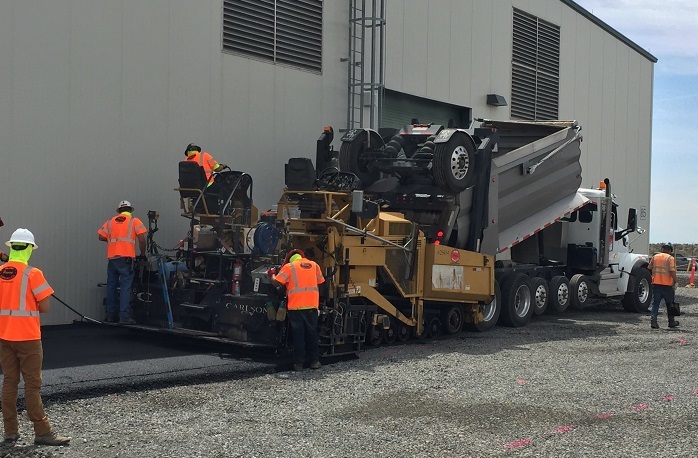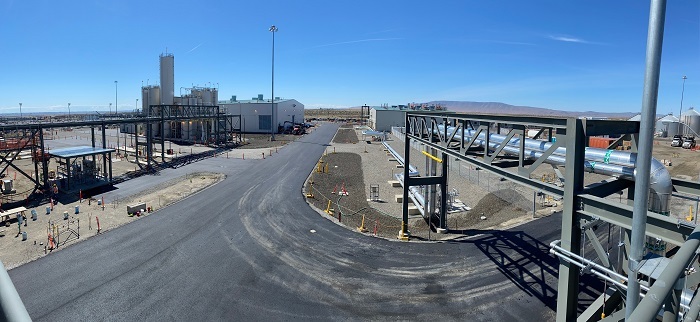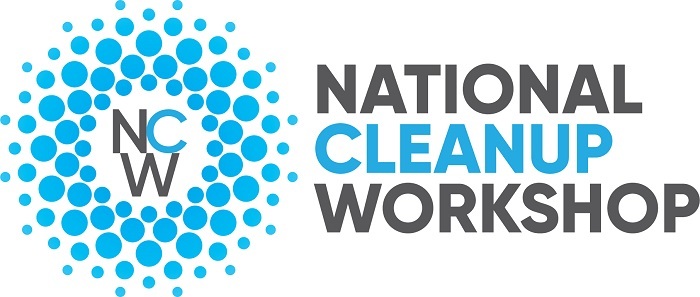
 RICHLAND, Wash. – Before and after views: the landscape around EM’s Hanford Waste Treatment and Immobilization Plant (WTP) continues to show signs of progress. Inland Asphalt, part of CRH Group, a subcontractor to WTP contractor Bechtel National Inc., is paving roads and parking lots around the future operational area of the plant, which supports one of EM’s 2020 priorities: complete Direct-Feed Low-Activity Waste construction and turn-over to commissioning. While taking advantage of the warm summer weather and using COVID-19 safety protocols, this work will continue over the next several weeks to establish nearly 620,000 square feet of permanent walkways and roadways.Click here to watch a video about this project.
-Contributor: Bechtel National Inc.
 Concrete bases are in place for the Waste Isolation Pilot Plant's new fire water system tanks.
CARLSBAD, N.M. – Millions of dollars in new and old infrastructure needs protecting at the EM Waste Isolation Pilot Plant (WIPP).
That’s the goal of WIPP’s $24-million fire protection infrastructure project, which is required to meet DOE and other federal nuclear safety requirements. When the work is complete, a 10,000-foot loop and its connectors that carry water to fight fires will replace an aging system installed more than 30 years ago when the waste repository was being developed.
WIPP is also adding a massive new ventilation system, known as the Safety Significant Confinement Ventilation System, as well as a new utility shaft that reaches 2,275 feet underground, providing increased air as part of the ventilation system. The fire protection loop will encompass all of it.
“This is an important project; parts of it are safety significant for nuclear safety,” said Steve Smith, capital infrastructure project manager with Nuclear Waste Partnership, the WIPP management and operations contractor. “The system we currently have is old, and it’s directly buried into the ground. This will give us a system we can rely on.”
The fire protection infrastructure project, slated for completion in 2022, is being done in phases. The first two phases include large underground fire mains, a new pumping system with a pumphouse, and large water tanks. The third phase will connect buildings to the loop. The fourth phase includes installation of electrical panels, smoke and heat detectors, and pull boxes in more than two dozen buildings. The site’s central monitoring room, which will accept all system inputs, is being remodeled with state-of-the-art computers and monitors.
The loop design includes numerous crossover points, allowing water to flow where it’s needed if part of the system is blocked or disabled.
Backup systems are central to the project. The pumphouse will have an alternate electric pump, which will in turn be backed up by diesel power. The system can also be hooked up to the site fire department’s pumper truck to maintain pressure.
The pumphouse will be constructed of reinforced concrete, designed to withstand a severe tornado.
A pair of 200,000-gallon tanks are being fabricated and painted this month for installation in August. They will sit atop concrete bases on the northeast corner of the site. Those tanks will replace a single 180,000-gallon tank located near the site’s guard and security building. That tank and an adjacent tank will be used for potable water once the new system comes online.
The fire protection loop will extend across the WIPP access road to the area of the new utility shaft, as well as the new ventilation system.
The new fire loop will provide an increased volume of water through new fire hydrants, and the supply line from the hydrant to the pumper will be replaced with an expanded line, allowing for an increase in volume of 66 percent.
“The WIPP Fire Department is very excited about the new fire loop,” WIPP Fire Chief Nick Perrone said. “This is a game changer for the WIPP Fire Department and how we can and will handle any fire-type events.”
-Contributor: Roy Neese
 Characterization equipment operators Tim Carlton, left, and Todd Shepley perform a virtual equipment test.
AIKEN, S.C. – In a first for the Solid Waste Management Facility (SWMF) at the Savannah River Site (SRS), employees completed equipment tests virtually, due to the COVID-19 pandemic.
The tests were designed to ensure proper installation and operation of two pieces of equipment used to characterize transuranic (TRU) waste at the facility. TRU waste consists of solid materials, such as clothing, tools, rags, residue, debris, and other items contaminated with trace amounts of plutonium. All TRU waste at SRS is characterized before it can be shipped to the Waste Isolation Pilot Plant (WIPP) for permanent disposal. This ensures the waste is allowed by WIPP.
“Due to the COVID-19 travel restrictions in place at the time, acceptance tests were performed using video calls for the first time ever,” Solid Waste Programs Manager Kerri Crawford said. “An initial test was performed to ensure the video call could accurately meet requirements with both onsite and offsite personnel, and SRS subject-matter experts. The initial test was successful, and we completed the required acceptance testing while the travel restrictions were still in place.”
Following the successful testing, the equipment was calibrated. It will be certified for use in TRU waste characterization.
After TRU waste characterization efforts at SWMF are complete, the equipment will be used elsewhere at SRS.
“For example, criticality control overpack storage and shipping containers storing plutonium down-blend will be characterized, stored, and shipped from the Site’s K Area Complex storage and production facility instead of from SWMF,” Crawford said.
“Doing site acceptance testing through video is an inventive and effective way to ensure continued work during the COVID-19 pandemic,” said Sonitza Blanco, director of the DOE-Savannah River Waste Disposition Programs Division. “This is something we will evaluate for future use as a cost savings.”
-Contributor: Lindsey MonBarren
 The 2020 National Cleanup Workshop is being revamped to be a virtual workshop on Sept. 16, 2020. The half-day event will feature remarks from Under Secretary for Science Paul Dabbar and senior DOE officials, state and local government officials, and industry leaders. They will discuss key issues facing the DOE complex in the year ahead and celebrate important progress made this year.
Last year we celebrated 30 years of EM’s cleanup program. This year’s agenda will focus on continuing success and overcoming adversity with moderated discussions about the path forward for EM’s strategic vision, contracting updates, and regulatory successes.
A revised agenda is in development. For more information, please click here.
|